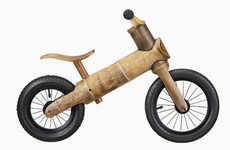
The 3D Printed Metal Bicycle Frame is Touted as the First of Its Kind
Meghan Young — February 21, 2014 — Eco
3D-printed bike parts might not be anything new and exciting, but the 3D printed metal bicycle frame certainly is. The key words in that term is 'metal' and 'frame.' These frames are being touted as the first of its kind both in scale and material. Although it is a one-offf creation, it is one for the books.
Designed by additive manufacturing firm Renishaw in joint effort with Empire Cycles, the 3D printed metal bicycle frame is modelled after the latter's MX6-EVO version. Made out of titanium alloy rather than aluminum, no material is wasted as it is with casting. Although titanium is more expensive than aluminum, by saving material as well as cost of tooling, it works out to be about the same. The bike is currently being tested.
Designed by additive manufacturing firm Renishaw in joint effort with Empire Cycles, the 3D printed metal bicycle frame is modelled after the latter's MX6-EVO version. Made out of titanium alloy rather than aluminum, no material is wasted as it is with casting. Although titanium is more expensive than aluminum, by saving material as well as cost of tooling, it works out to be about the same. The bike is currently being tested.
Trend Themes
1. 3d-printed Metal Bicycle Frame - Additive manufacturing firms and bicycle manufacturers are likely to explore potential design opportunities with 3D-printed metal bicycle frames.
2. Digitally Fabricated Parts - More firms and DIY enthusiasts are likely to experiment with 3D printing to produce complex yet lightweight designs that are also cost-effective.
3. Sustainable Manufacturing - Manufacturing companies are likely to explore additive manufacturing as a sustainable solution to traditional manufacturing drawbacks like high wastage of materials, slower production times and higher costs.
Industry Implications
1. Additive Manufacturing - Additive manufacturing firms have an opportunity to explore the potential of 3D-printed metal bicycle frames, which allow for precision designing without the wastage of materials.
2. Bicycle Manufacturing - Bicycle manufacturers have an opportunity to partner with additive manufacturing companies to produce unique, sustainable, and potentially commercially viable bicycle frames that can help distinguish their products from competitors.
3. Sustainable Manufacturing - Manufacturing firms, especially those with high wastage of materials, can reduce their environmental footprint and save costs by adopting and investing in 3D printing technologies such as additive manufacturing that can help manufacture complex parts and products with little to no wastage of materials.
6.1
Score
Popularity
Activity
Freshness























